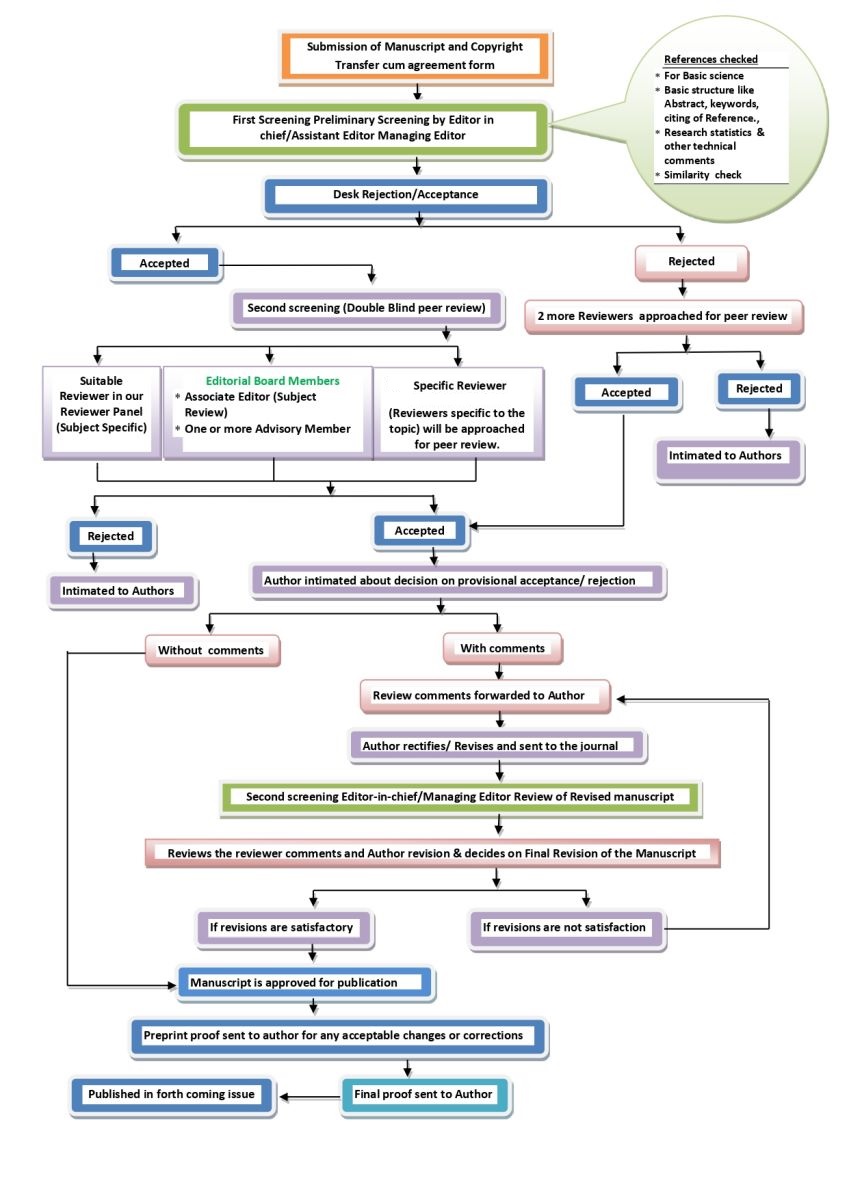Peer Review Process
All submitted materials, including manuscripts, cover letters, texts, figures like charts, tables, and annexures, are carefully reviewed (Peer Review - First Screening) by our Chief Editor, Assistant Editor, and Managing Editor before being accepted for publication in the Journal. This initial review comprises checking the reference style, relevance to basic medical science, rational and basic article structure, such as the abstract, keyword, introduction, results etc.
Authors are informed of the pending requirements if they become necessary. The authors must submit the necessary documents again after making any necessary revisions. Additionally, the assistant editor reviews the manuscript's content and concept and provides his feedback.
The manuscript will be rejected if it falls short of the required standard or if it is not relevant to the IJTOS. The author will need to send corrections for the remarks/comments from the subsequent peer review, therefore first screening acceptance does not ensure full acceptance.
The manuscript will then be sent to at least one Associate Editor (for subject review), one or more Advisory Editor (for Subject and content review), and not fewer than two Reviewers in our Reviewer Panel once it has passed the first round of screening for peer review. The manuscript will also be sent to few possible peer reviewers (Specific Reviewers) who have accepted to review and who are not members of our Editorial Board or reviewer panel but who have recently worked on or published articles that are very close and near to the submitted manuscript's aim and goal. This will guarantee a thorough review of the manuscript to recentness. This specific reviewer review evaluation is done to determine the manuscript's recent relevance, need for the study, recent appropriate technique, accurate interpretation of the results, good description of the results, etc.
All reviewers are expected to complete their assignments on time and in full compliance with all standards. To meet deadlines, they must work with the editorial office. They must annotate the book with their remarks and recommendations in the designated spaces. The reviewer is asked to conduct a fair and unbiased assessment of all the elements expected from a research manuscript, including the content, originality, applicability of the findings, data analysis and interpretation, etc. They are also asked to offer helpful criticism, suggestions, and recommendations.
When determining if the work is appropriate, the reviewer should also take into account the English language, grammar, and other issues. For more information, please see "For Reviewers" on our journal's home page. We employ a double-blind peer review method, in which neither the reviewers' nor the authors' names are revealed to one another, to enable an objective, fair evaluation of the paper. The text is kept under strict confidentially until it is accepted and published. The list of reviewers wouldn't be released until the manuscript was published. The author is given the reviewer's suggestions for correction or rectification, and they are expected to be send the rectification back to the journal as early as possible which will be subjected to evaluation and unrectified comments will be sent back to author. This continues until the reviewer approves the manuscript (with or without condition statement). The manuscript would then be given to the managing editor or editor in chief (second screening) along with the reviewers' comments and any necessary author corrections. It is at this point that the manuscript's final acceptance or rejection is decided, depending on the comments of the peer review. If the manuscript is ultimately accepted, an acceptance notification will be sent to the author without much delay. If the manuscript is rejected, however, the editor in chief may choose to send it to two additional reviewers (Reviewers 4 and 5). If both of them agree, the manuscript will be accepted for publication; however, if either of them disagrees, the manuscript will be rejected and returned to the author with reasons for rejection. The author has the right to appeal a reviewer's decision if they are unsatisfied with the decision and provide justification for why the document should be accepted. Based on the author's justifications, the editor in chief determines whether to reconsider for a second peer review procedure.
A pre-print proof with a potential DOI is delivered to the author for final proof correction and approval once the text is complete and all reviewer and editor comments have been addressed. The manuscript is produced as PDF files for publishing once the author makes final proof edits to the preprint proof version of the document.
We make every effort to peer-review every manuscript from the time it is submitted until it is published, and whenever a manuscript is found to be lacking in terms of its content, violating an embargo, the author engaging in unethical behavior, etc., the author will be asked to make corrections or provide an explanation. If the corrections or explanations are not adequate, the manuscript will be withheld from publication.
Please refer COPE FLOW charts and infographics - Full set - English https:doi.org/10.24318/cope.2019.2.26 version 2 : March 2021.
Screening Guidelines:
"Screening Guidelines" will be emailed to all reviewers and editorial board members who were chosen to participate in the peer review process for the relevant paper. These recommendations make it easier to check the document for errors, omissions, or other technical, scientific, logical, etc. requirements. However, they are expected to review in the direction of an error-free document. Reviewers are also permitted to go beyond what these screening standards suggest.
Editor "Manuscript screening guidelines"
The guidelines for manuscript screening shall be followed by each member of the Editorial Board. This is essential for ensuring that every board member adheres to an efficient editorial procedure. Only members have access to this "Manuscript screening guideline details".






